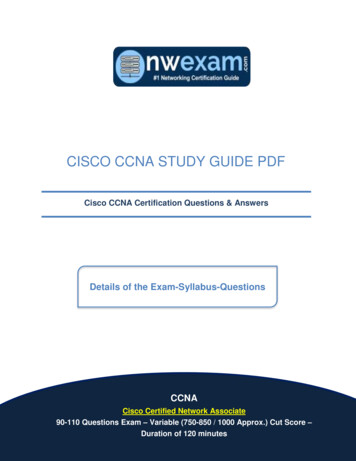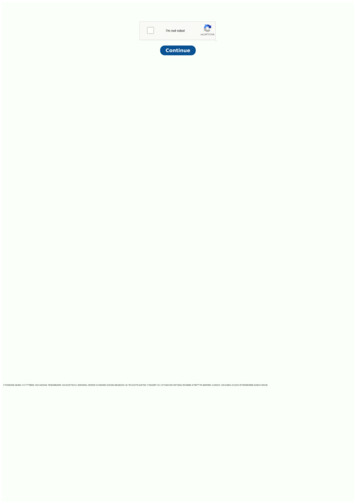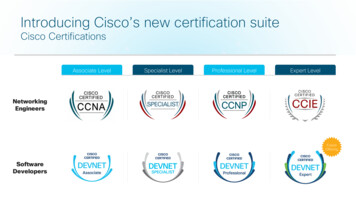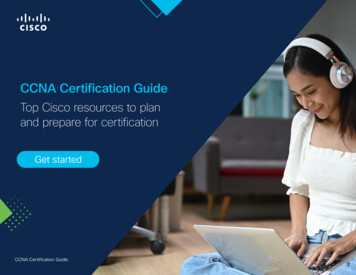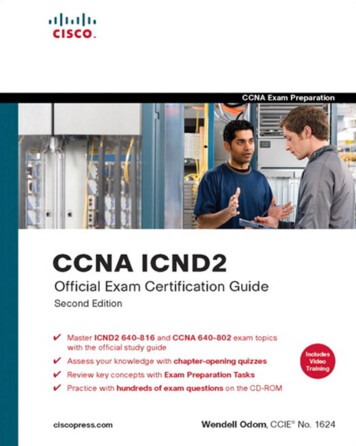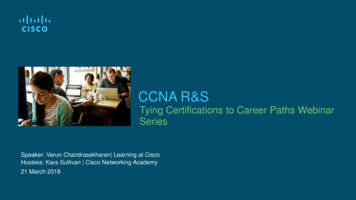
Transcription
31 Days Before Your CCNA ExamA Day-by-Day Review Guide for theCCNA 640-802 ExamSecond EditionAllan JohnsonCopyright 2009 Cisco Systems, Inc.Published by:Cisco Press800 East 96th StreetIndianapolis, IN 46240 USAAll rights reserved. No part of this book may be reproduced or transmittedin any form or by any means, electronic or mechanical, including photocopying, recording, or by any information storage and retrieval system,without written permission from the publisher, except for the inclusion ofbrief quotations in a review.Printed in the United States of AmericaFirst Printing November 2008Library of Congress Cataloging-in-Publication DataJohnson, Allan, 196231 days before your CCNA exam : a day-by-day review guide for theCCNA640-802 exam / Allan Johnson. -- 2nd ed.p. cm.Originally published: Indianapolis, IN : Cisco Press, c2007 undertitle: 31 days before your CCNA exam / Scott Bennett.ISBN 978-1-58713-197-4 (pbk.)Associate PublisherDave DusthimerCisco Press ProgramManagerJeff BradyExecutive EditorMary Beth RayManaging EditorPatrick KanouseSenior DevelopmentEditorChristopher ClevelandProject EditorMandie FrankCopy EditorBarbara HachaTechnical EditorsRick Graziani,Kenneth StewartEditorial AssistantVanessa EvansBook & Cover DesignerLouisa AdairCompositionTnT Design, Inc.1. Electronic data processing personnel--Certification. 2. Computernetworks--Examinations--Study guides. I. Bennett, Scott, CCNA 31 daysIndexerLisa Stumpfbefore your CCNA exam. II. Title. III. Title: Thirty one days before yourCCNA exam.ProofreaderPaula LowellTK5105.5.B443 2008004.6--dc222008044139ISBN-13: 978-1-58713-197-4ISBN-10: 1-58713-197-8
xxiv31 Days Before Your CCNA ExamIcons Used in This BookRouterWirelessRouterWirelessAccess PointHubHub(alternate)Multilayer SwitchSwitchATM SwitchRelay SwitchWAN SwitchPBX SwitchCisco ASARouter withFirewallPIX FirewallFirewallVPNConcentratorVDSLAMIP PhoneCSU/DSUAccess ServerPhoneNetworkManagementServerEthernet ConnectionServerWebServerSerial LineConnectionLaptopVoice-EnabledAccess ServerIP/TV rk CloudWireless ConnectionCommand Syntax ConventionsThe conventions used to present command syntax in this book are the same conventions used inthe IOS Command Reference. The Command Reference describes these conventions as follows: Boldface indicates commands and keywords that are entered literally as shown. In actual configuration examples and output (not general command syntax), boldface indicates commandsthat are manually input by the user (such as a show command).
xxv Italic indicates arguments for which you supply actual values. Vertical bars ( ) separate alternative, mutually exclusive elements. Square brackets ([ ]) indicate an optional element. Braces ({ }) indicate a required choice. Braces within brackets ([{ }]) indicate a required choice within an optional element.IntroductionYou are almost there! If you’re reading this Introduction, you’ve probably already spent a considerableamount of time and energy pursuing your CCNA certification. Regardless of how you got to thispoint in your travels through your CCNA studies, 31 Days Before Your CCNA Exam most likelyrepresents the last leg of your journey on your way to the destination: to become a Cisco CertifiedNetwork Associate. However if you are like me, you might be reading this book at the beginningof your studies. If such is the case, this book provides you with an excellent overview of the material you must now spend a great deal of time studying and practicing. I must warn you, though;unless you are extremely well versed in networking technologies and have considerable experienceconfiguring and troubleshooting Cisco routers and switches, this book will not serve you well asthe sole resource for CCNA exam preparation. Therefore, let me spend some time discussing myrecommendations for study resources.Study ResourcesCisco Press offers an abundance of CCNA-related books to serve as your primary source for learninghow to install, configure, operate, and troubleshoot medium-size routed and switched networks.See the inside cover of this book for a quick list of my recommendations.Foundational ResourcesFirst on the list must be Wendell Odom’s CCNA Official Exam Certification Library, Third Edition(ISBN: 1587201836). If you do not buy any other books, buy this set of two. Wendell’s method ofteaching, combined with his technical expertise and down-to-earth style, is unsurpassed in our industry.As you read through his books, you sense that he is sitting right there next to you walking youthrough the material. The practice exams and study materials on the CD in the back of the bookare worth the price of the book. There is no better resource on the market for a CCNA candidate.Next on the list must be Steve McQuerry’s Authorized Self-Study Guide CCNA Preparation Library,Seventh Edition (ISBN: 1587054647). These two books are indispensable to those students whotake the two Cisco recommended training classes for CCNA preparation: Interconnecting CiscoNetwork Devices 1 (ICND1) and Interconnecting Cisco Network Devices 2 (ICND2). These courses,available through Cisco Training Partners in a variety of formats, are usually of a very short duration(1 to 6 weeks) and are geared toward the industry professional already working in the field of networking. Steve’s books serve the reader well as a concise, but thorough, treatment of the CCNAexam topics. His method and approach often differ from and complement Wendell’s approach. Irecommend that you also refer to these books.
xxvi31 Days Before Your CCNA ExamIf you are a Cisco Networking Academy student, you are blessed with access to the online versionof the CCNA curriculum and the wildly popular Packet Tracer network simulator. Although there aretwo versions of the CCNA curriculum—Discovery and Exploration—I chose to use the fourCCNA Exploration courses in my daily review of the exam topics. The Exploration curriculumprovides a comprehensive overview of networking, from fundamentals to advanced applicationsand services. The Exploration courses emphasize theoretical concepts and practical application,while providing opportunities for students to gain the skills and hands-on experience needed todesign, install, operate, and maintain networks in small-to-medium businesses, as well as enterpriseand service provider environments. In an Academy class, not only do you have access to PacketTracer, but you have access to extensive, guided labs and real equipment on which to practice yourCCNA skills. To learn more about CCNA Exploration and to find an Academy near you, rse catalog/CCNAexploration.html.However, if you are not an Academy student but would like to benefit from the extensive authoringdone for these courses, you can buy any or all of the CCNA Exploration Companion Guides (CG)and Lab Study Guides (LSG) of the Academy’s popular online curriculum. Although you will nothave access to the Packet Tracer network simulator software, you will have access to the tirelesswork of an outstanding team of Cisco Academy Instructors dedicated to providing students withcomprehensive and engaging CCNA preparation course material. The titles and ISBNs for theCCNA Exploration CGs and LSGs are as follows: Network Fundamentals (CG ISBN: 1587132087; LSG ISBN: 1587132036) Routing Protocols and Concepts (CG ISBN: 1587132060; LSG ISBN: 1587132044) LAN Switching and Wireless (CG ISBN: 1587132079; LSG ISBN: 1587132028) Accessing the WAN (CG ISBN: 1587132052; LSG ISBN: 158713201X)You can find these books at www.ciscopress.com by clicking the CISCO NETWORKINGACADEMY link.Supplemental ResourcesIn addition to the book you hold in your hands, I recommend two more supplemental resources toaugment your final 31 days of review and preparation.First, Eric Rivard and Jim Doherty are coauthors of CCNA Flash Cards and Exam Practice Pack,Third Edition (ISBN: 1587201909). The text portion of the book includes more than 700 flashcards that quickly review exam topics in bite-sized pieces. Also included are nearly 200 pages ofquick-reference sheets designed for late-stage exam preparation. And the included CD features atest engine with more than 500 CCNA practice exam questions.Second, Wendell Odom has put together an excellent collection of more than four hours of personal,visual instruction in one package, titled CCNA Video Mentor, Second Edition (ISBN: 1587201917).It contains a DVD with 20 videos and a lab manual. Wendell walks you through common Ciscorouter and switch configuration topics designed to develop and enhance your hands-on skills.The Cisco Learning NetworkFinally, if you have not done so already, you should now register with the Cisco Learning Networkat http://cisco.hosted.jivesoftware.com/. Sponsored by Cisco, the Cisco Learning Network is a freesocial-learning network where IT professionals can engage in the common pursuit of enhancing
xxviiand advancing their IT careers. Here you will find many resources to help you prepare for yourCCNA exam, as well as a community of like-minded people ready to answer your questions, helpyou with your struggles, and share in your triumphs.So which resources should you buy? That question is largely up to how deep your pockets are or howmuch you like books. If you’re like me, you must have it all! I admit it. My bookcase is a testamentto my Cisco “geekness.” But if you are on a budget, choose one of the foundational study resourcesand one of the supplemental resources, such as Wendell Odom’s certification library and Rivard/Doherty’s flash cards. Whatever you choose, you will be in good hands. Any or all of these authorswill serve you well.Goals and MethodsThe main goal of this book is to provide you with a clear and succinct review of the CCNA objectives. Each day’s exam topics are grouped into a common conceptual framework that uses the following format: A title for the day that concisely states the overall topic A list of one or more CCNA 640-802 exam topics to be reviewed A Key Topics section to introduce the review material and quickly orient you to the day’sfocus An extensive review section consisting of short paragraphs, lists, tables, examples, and graphics A Study Resources section to provide a quick reference for locating more in-depth treatmentof the day’s topicsThe book counts down starting with Day 31 and continues through exam day to provide post-testinformation. You will also find a calendar and checklist that you can tear out and use during yourexam preparation inside the book.Use the calendar to enter each actual date beside the countdown day and the exact day, time, andlocation of your CCNA exam. The calendar provides a visual for the time that you can dedicate toeach CCNA exam topic.The checklist highlights important tasks and deadlines leading up to your exam. Use it to help youmap out your studies.Who Should Read This Book?The audience for this book is anyone finishing preparation for taking the CCNA 640-802 exam. Asecondary audience is anyone needing a refresher review of CCNA exam topics—possibly beforeattempting to recertify or sit for another certification to which the CCNA is a prerequisite.Getting to Know the CCNA 640-802 ExamFor the current certifications, announced in June 2007, Cisco created the ICND1 (640-822) andICND2 (640-816) exams, along with the CCNA (640-802) exam. To become CCNA certified, youcan pass both the ICND1 and ICND2 exams, or just the CCNA exam. The CCNA exam covers allthe topics on the ICND1 and ICND2 exams, giving you two options for gaining your CCNA certification. The two-exam path gives people with less experience a chance to study for a smaller set
xxviii31 Days Before Your CCNA Examof topics at one time. The one-exam option provides a more cost-effective certification path forthose who want to prepare for all the topics at once. This book focuses exclusively on the one-exampath using the entire list of exam topics for the CCNA 640-802 exam.Currently for the CCNA exam, you are allowed 90 minutes to answer 50–60 questions. Use thefollowing steps to access a tutorial at home that demonstrates the exam environment before you goto take the exam:Step 1Visit http://www.vue.com/cisco.Step 2Look for a link to the certification tutorial. Currently, it can be found on the right sideof the web page under the heading Related Links.Step 3Click the Certification tutorial link.When you get to the testing center and check in, the proctor verifies your identity, gives you somegeneral instructions, and then takes you into a quiet room containing a PC. When you’re at the PC,you have a few things to do before the timer starts on your exam. For instance, you can take thetutorial to get accustomed to the PC and the testing engine. Every time I sit for an exam, I gothrough the tutorial, even though I know how the test engine works. It helps me settle my nervesand get focused. Anyone who has user-level skills in getting around a PC should have no problemswith the testing environment.When you start the exam, you are asked a series of questions. Each question is presented one at atime and must be answered before moving on to the next question. The exam engine does not letyou go back and change your answer. The exam questions can be in one of the following formats: Multiple choice Fill-in-the-blank Drag-and-drop Testlet Simlet SimulationThe multiple-choice format requires that you point and click a circle or check box next to the correctanswer or answers. Cisco traditionally tells you how many answers you need to choose, and thetesting software prevents you from choosing too many or too few.Fill-in-the-blank questions typically require you only to type numbers. However if words arerequested, the case does not matter unless the answer is a command that is case sensitive (such aspasswords and device names when configuring authentication).Drag-and-drop questions require you to click and hold, move a button or icon to another area, andrelease the mouse button to place the object somewhere else—typically in a list. For some questions,to get the question correct, you might need to put a list of five things in the proper order.Testlets contain one general scenario and several multiple-choice questions about the scenario.These are ideal if you are confident in your knowledge of the scenario’s content because you canleverage your strength over multiple questions.
xxixA simlet is similar to a testlet in that you are given a scenario with several multiple-choice questions.However, a simlet uses a network simulator to allow you access to a simulation of the commandline of Cisco IOS Software. You can then use show commands to examine a network’s currentbehavior and answer the question.A simulation also uses a network simulator, but you are given a task to accomplish, such as implementing a network solution or troubleshooting an existing network implementation. You do this byconfiguring one or more routers and switches. The exam then grades the question based on theconfiguration you changed or added. A newer form of the simulation question is the GUI-basedsimulation, where a graphical interface like that found on a Linksys router or the Cisco SecurityDevice Manager is simulated.What Topics Are Covered on the CCNA ExamThe topics of the CCNA 640-802 exam focus on the following eight key categories: Describe how a network works. Configure, verify and troubleshoot a switch with VLANs and interswitch communications. Implement an IP addressing scheme and IP Services to meet network requirements in amedium-size enterprise branch office network. Configure, verify, and troubleshoot basic router operation and routing on Cisco devices. Explain and select the appropriate administrative tasks required for a WLAN. Identify security threats to a network and describe general methods to mitigate those threats. Implement, verify, and troubleshoot NAT and ACLs in a medium-size enterprise branch officenetwork. Implement and verify WAN links.Although Cisco outlines general exam topics, it is possible that not all topics will appear on theCCNA exam and that topics that are not specifically listed might appear on the exam. The examtopics provided by Cisco and included in this book are a general framework for exam preparation.Be sure to check the Cisco website for the latest exam topics.Cisco Networking Academy Student Discount VoucherIf you are a Cisco Networking Academy student, you have the opportunity to earn a discountvoucher to use when registering and paying for your exam with Pearson VUE. To receive thediscount voucher, you must complete all four courses of the CCNA Exploration curriculum andreceive a score of 75 percent or higher on your first attempt of the final exam for the final CCNAExploration course, Accessing the WAN. The amount of the discount varies by region and testingcenter, but typically it has been as much as 50% off the full exam price. Log in to the AcademyConnection and click Help at the top of the page to research more information on receiving adiscount voucher.
xxx31 Days Before Your CCNA ExamRegistering for the CCNA 640-802 ExamIf you are starting your 31 Days to Your CCNA today, register for the exam right now. In my testing experience, there is no better motivator than a scheduled test date staring me in the face. I’mwilling to bet it’s the same for you. Don’t worry about unforeseen circumstances. You can cancelyour exam registration for a full refund up to 24 hours before taking the exam. So if you’re ready,you should gather the following information in Table I-1 and register right now!Table I-1Personal Information for CCNA 640-802 Exam RegistrationItemNotesLegal NameSocial Security or Passport NumberCisco Certification ID or Test ID1Cisco Academy Username2Cisco Academy ID Number 2Company NameValid Email AddressVoucher Number 2Method of PaymentApplies to exam candidates if you have previously taken a Cisco certification exam (such as the ICND1 exam)1Applies to Cisco Networking Academy students only2To register for an exam, contact Pearson VUE via one of the following methods: Online: http://www.vue.com/cisco. By phone: In the United States and Canada call 1-800-829-6387, option 1, then option 4.Check the website for information regarding other countries.The process and available test times will vary based on the local testing center you choose.Remember, there is no better motivation for study than an actual test date. Sign up today.
Day 28Connecting Switches and EthernetTechnologyCCNA 640-802 Exam Topics Explain the technology and media access control method for Ethernet networks. Select the appropriate media, cables, ports, and connectors to connect switches to other network devices and hosts.Key TopicsEthernet has continued to evolve from the 10BASE2 flavor capable of speeds up to 185 Mbps tothe newest 10GigE (10 Gigabit Ethernet) capable of speeds up to 10 Gbps. Since 1985, IEEE hascontinued to upgrade the 802.3 standards to provide faster speeds without changing the underlyingframe structure. This feature, among others, has made Ethernet the choice for LAN implementations worldwide. Today we review Ethernet technologies and operation at both the data link andphysical layer.Ethernet Overview802.3 is the IEEE standard for Ethernet, and both terms are commonly used interchangeably. Theterms Ethernet and 802.3 both refer to a family of standards that together define the physical anddata link layers of the definitive LAN technology. Figure 28-1 shows a comparison of Ethernetstandards to the OSI model.Ethernet Standards and the OSI ModelLLCSublayerOSI LayersLAN SpecificationFDDIToken Ring/iEEE 802.6IEEE 802.3ab(GigabitEthernet over Copper)IEEE sicalLayerIEEE 802.3uPhysicalLayerMACSublayerIEEE 802.2IEEE 802.3Data LinkLayerEthernetFigure 28-1
3431 Days Before Your CCNA ExamEthernet separates the functions of the data link layer into two distinct sublayers: Logical Link Control (LLC) sublayer: Defined in the 802.2 standard. Media Access Control (MAC) sublayer: Defined in the 802.3 standard.The LLC sublayer handles communication between the network layer and the MAC sublayer. Ingeneral, LLC provides a way to identify the protocol that is passed from the data link layer to thenetwork layer. In this way, the fields of the MAC sublayer are not populated with protocol typeinformation, as was the case in earlier Ethernet implementations.The MAC sublayer has two primary responsibilities: Data Encapsulation: Includes frame assembly before transmission, frame parsing uponreception of a frame, data link layer MAC addressing, and error detection. Media Access Control: Because Ethernet is a shared media and all devices can transmit atany time, media access is controlled by a method called Carrier Sense Multiple Access withCollision Detection (CSMA/CD).At the physical layer, Ethernet specifies and implements encoding and decoding schemes thatenable frame bits to be carried as signals across both unshielded twisted-pair (UTP) copper cablesand optical fiber cables. In early implementations, Ethernet used coaxial cabling.Legacy Ethernet TechnologiesEthernet is best understood by first considering the two early Ethernet specifications—10BASE5and 10BASE2. With these two specifications, the network engineer installs a series of coaxialcables connecting each device on the Ethernet network, as shown in Figure 28-2.Figure 28-2Ethernet Physical and Logical Bus TopologyTopologyPhysical: BusLogical: BusThe series of cables creates an electrical circuit, called a bus, which is shared among all devices onthe Ethernet. When a computer wants to send some bits to another computer on the bus, it sends anelectrical signal, and the electricity propagates to all devices on the Ethernet.With the change of media to UTP and the introduction of the first hubs, Ethernet physical topologies migrated to a star as shown in Figure 28-3.Regardless of the change in the physical topology from a bus to a star, hubs logically operate similar to a traditional bus topology and require the use of CSMA/CD.
Day 28Figure 28-335Ethernet Physical Star and Logical Bus TopologyTopologyPhysical: StarLogical: BusHubCSMA/CDBecause Ethernet is a shared media where every device has the right to send at any time, it alsodefines a specification for how to ensure that only one device sends traffic at a time. TheCSMA/CD algorithm defines how the Ethernet logical bus is accessed.CSMA/CD logic helps prevent collisions and also defines how to act when a collision does occur.The CSMA/CD algorithm works like this:1. A device with a frame to send listens until the Ethernet is not busy.2. When the Ethernet is not busy, the sender(s) begin(s) sending the frame.3. The sender(s) listen(s) to make sure that no collision occurred.4. If a collision occurs, the devices that had been sending a frame each send a jamming signalto ensure that all stations recognize the collision.5. After the jamming is complete, each sender randomizes a timer and waits that long beforetrying to resend the collided frame.6. When each random timer expires, the process starts again from the beginning.When CSMA/CD is in effect, it also means that a device’s network interface card (NIC) is operating in half-duplex mode—either sending or receiving frames. CSMA/CD is disabled when a NICautodetects that it can operate in—or is manually configured to operate in—full duplex mode. Infull duplex mode, a NIC can send and receive simultaneously.Legacy Ethernet SummaryToday, you might occasionally use LAN hubs, but you will more likely use switches instead ofhubs. However, keep in mind the following key points about the history of Ethernet: The original Ethernet LANs created an electrical bus to which all devices connected. 10BASE2 and 10BASE5 repeaters extended the length of LANs by cleaning up the electricalsignal and repeating it—a Layer 1 function—but without interpreting the meaning of the electrical signal.
3631 Days Before Your CCNA Exam Hubs are repeaters that provide a centralized connection point for UTP cabling—but they stillcreate a single electrical bus, shared by the various devices, just like 10BASE5 and 10BASE2. Because collisions could occur in any of these cases, Ethernet defines the CSMA/CD algorithm, which tells devices how to both avoid collisions and take action when collisions dooccur.Current Ethernet TechnologiesRefer back to Figure 28-1 and notice the different 802.3 standards. Each new physical layer standard from the IEEE requires many differences at the physical layer. However, each of these physical layer standards uses the same 802.3 header, and each uses the upper LLC sublayer as well.Table 28-1 lists today’s most commonly used IEEE Ethernet physical layer standards.Table 28-1Today’s Most Common Types of EthernetCommonNameSpeedAlternativeNameName of IEEEStandardCable Type,Maximum LengthEthernet10 Mbps10BASE-TIEEE 802.3Copper, 100 mFast Ethernet100 Mbps100BASE-TXIEEE 802.3uCopper, 100 mGigabit Ethernet1000 Mbps1000BASE-LX,1000BASE-SXIEEE 802.3zFiber, 550 m (SX)5 km (LX)Gigabit Ethernet1000 Mbps1000BASE-TIEEE 802.3abCopper, 100 m10GigE(Gigabit Ethernet)10 Gbps10GBASE-SR,10GBASE-LRIEEE 802.3aeFiber, up to 300 m (SR),up to 25 km (LR)10GigE(Gigabit Ethernet)10 Gbps10GBASE-TIEEE 802.3anCopper, 100 mUTP CablingThe three most common Ethernet standards used today—10BASE-T (Ethernet), 100BASE-TX(Fast Ethernet, or FE), and 1000BASE-T (Gigabit Ethernet, or GE)—use UTP cabling. Some keydifferences exist, particularly with the number of wire pairs needed in each case and in the type(category) of cabling.The UTP cabling used by popular Ethernet standards include either two or four pairs of wires. Thecable ends typically use an RJ-45 connector. The RJ-45 connector has eight specific physical locations into which the eight wires in the cable can be inserted, called pin positions or, simply, pins.The Telecommunications Industry Association (TIA) and the Electronics Industry Alliance (EIA)define standards for UTP cabling, color coding for wires, and standard pinouts on the cables.Figure 28-4 shows two TIA/EIA pinout standards, with the color coding and pair numbers listed.
Day 28Figure 28-437TIA/EIA Standard Ethernet Cabling PinoutsPinouts1 G/W2 Green3 O/W4 Blue5 Blue/W6 Orange7 Brown/W8 BrownPair 2Pair 3Pair 3 Pair 1 Pair 4Pair 2 Pair 1 Pair 41234567 81234567 8T568AT568BPinouts1 O/W2 Orange3 G/W4 Blue5 Blue/W6 Green7 Brown/W8 BrownFor the exam, you should be well prepared to choose which type of cable (straight-through orcrossover) is needed in each part of the network. In short, devices on opposite ends of a cable thatuse the same pair of pins to transmit need a crossover cable. Devices that use an opposite pair ofpins to transmit need a straight-through cable. Table 28-2 lists typical devices and the pin pairsthey use, assuming that they use 10BASE-T and 100BASE-TX.Table 28-210BASE-T and 100BASE-TX Pin Pairs UsedDevices That Transmit on 1,2 and Receive on 3,6Devices That Transmit on3,6 and Receive on 1,2PC NICsHubsRoutersSwitchesWireless Access Point (Ethernet interface)N/ANetworked printers (printers that connect directly to the LAN)N/A1000BASE-T requires four wire pairs because Gigabit Ethernet transmits and receives on each ofthe four wire pairs simultaneously.However, Gigabit Ethernet does have a concept of straight-through and crossover cables, with aminor difference in the crossover cables. The pinouts for a straight-through cable are the same—pin 1 to pin 1, pin 2 to pin 2, and so on. The crossover cable crosses the same two-wire pair as thecrossover cable for the other types of Ethernet—the pair at pins 1,2 and 3,6—as well as crossingthe two other pairs (the pair at pins 4,5 with the pair at pins 7,8).Benefits of Using SwitchesA collision domain is a set of devices whose frames could collide. All devices on a 10BASE2,10BASE5, or any network using a hub risk collisions between the frames that they send, so alldevices on one of these types of Ethernet networks are in the same collision domain and useCSMA/CD to detect and resolve collisions.LAN switches significantly reduce, or even eliminate, the number of collisions on a LAN. Unlikehubs, switches do not create a single shared bus. Instead, switches do the following:
3831 Days Before Your CCNA Exam Switches interpret the bits in the received frame so that they can typically send the frame outthe one required port, rather than all other ports. If a switch needs to forward multiple frames out the same port, the switch buffers the framesin memory, sending one at a time, thereby avoiding collisions.In addition, switches with only one device cabled to each port of the switch allow the use of fullduplex operation. Full-duplex means that the NIC can send and receive concurrently, effectivelydoubling the bandwidth of a 100 Mbps link to 200 Mbps—100 Mbps for sending and 100 Mbpsfor receiving.These seemingly simple switch features provide significant performance improvements as compared with using hubs. In particular: If only one device is cabled to each port of a switch, no collisions can occur. Devices connected to one switch port do not share their bandwidth with devices connected toanother switch port. Each has its own separate bandwidth, meaning that a switch with 100Mbps ports has 100 Mbps of bandwidth per port.Ethernet AddressingThe IEEE defines the format and assignment of LAN addresses. To ensure a unique MAC address,the first half of the address identifies the manufacturer of the card. This code is called the organizationally unique identifier (OUI). Each manufacturer assigns a MAC address with its own OUI asthe first half of the address. The second half of the address is assigned by the manufacturer and isnever used on another card or network interface with the same OUI. Figure 28-5 shows the structure of a
31 days before your CCNA exam : a day-by-day review guide for the CCNA 640-802 exam / Allan Johnson. -- 2nd ed. p. cm. Originally published: Indianapolis, IN : Cisco Press, c2007 under title: 31 days before your CCNA exam / Scott Bennett. ISBN 978-1-58713-197-4 (pbk.) 1. Electronic data processing personnel--Certification. 2. Computer

